The overwhelming tendency to talk about writing systems as linguistic codes (which they usually are in some sense) has often ignored other important aspects of writing. For instance, one way way we can study writing is as a practice or action, because writing is a thing you do. At CREWS we have been particularly interested in developing the ways we look at writing practices, because this is an area with important ramifications for the way writing looks and the place of writing in a society (and in fact you can hear me speaking about some of these issues at the beginning of this seminar video).

But how can we reconstruct the ways in which writing was done, accomplished or performed in the ancient world? The nature of the act of writing is extremely dependant on a whole range of factors, from cultural attitudes and social setting to technical expertise and interactions with oral traditions. And choices about the kinds of things you write on, the kinds of things you write with and the techniques you use to ‘apply’ the writing are central to these practices. There are a number of different ways of approaching the question, one of which is by looking at ancient visual depictions of the act of writing. This is what we will focus on in this post.
Depictions of the act of writing vary greatly in different ancient societies, some of which offer a wealth of evidence while others offer none (other than the inscribed objects that were the outcome of their writing practices). I have previously written about the problems with reconstructing writing in the Mycenaean world, for example, where our evidence is very slim but a bit of Lego reconstruction helped to think through the issues!
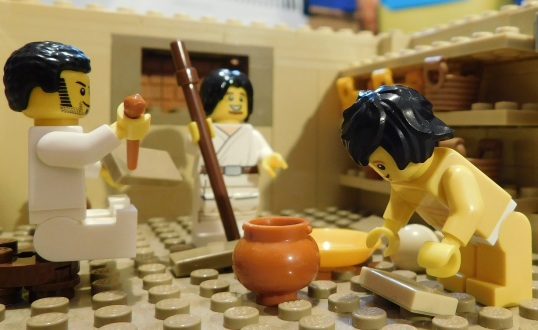
A good place to start is ancient Egypt, which is one of the areas that offers a great deal of evidence for what the act of writing looks like. But we have to remember that Egypt was quite exceptional and idiosyncratic in some of its best known writing practices. Writing in Egyptian hieroglyphs was considered to be a specialist ability to the extent that professional scribes were highly regarded and the most famous ones often held important positions, for instance in the royal court. From Egyptian scribe statues we have quite a strong impression of what a scribe looks like while in the act of writing – he (in these cases a man) sits, often cross-legged, and on top of his clothing holds a piece of papyrus pulled tight across his lap, which he writes on using a reed pen.
L>R: Seated scribe in the British Museum, 600 BC or after, Seated scribe in the New York Met, 1336-1323 BC, Seated scribe in the Louvre, 2600-2350 BC.
We actually know that there were women scribes in ancient Egypt too. I could not find any depictions known to be of a woman (other than of the goddess Seshat, see below), but I did come across this statuette of an unnamed scribe whose pose and body shape seemed to raise a questionmark over gender – though these are of course very subjective concepts, and the clothing and hairstyle are not out of place for a male scribe. The unusual pose is interesting, however, as here we see a scribe sitting in a position that presumably would not as easily have kept the papyrus taut across the lap. They look rather more comfortable and even natural than the usual seated figure.
![egyptian woman scribe]](https://crewsproject.files.wordpress.com/2020/05/egyptian-woman-scribe.jpg?w=1080)
But we also have to remember that this is only one kind of Egyptian writing. The person who painted the hieroglyphs in a tomb or on a coffin, or the person who cut hieroglyphs into a stone stela, would not have been sitting cross-legged with a reed pen and papyrus. They are also less likely to be the highly regarded individuals honoured by some of the statues we have seen above. We do have some depictions of scribes in other poses while writing, perhaps showing us a writing act that is more immediate – jotting something down rather than taking time to compose a visually impressive text. In the two images below, for instance, we see scribes depicted in relief carvings, seated in a hunched position on the left and standing in a bent position on the right.
Scribe depictions from the tomb of Horemheb. Left image courtesy of Merja Attia, here. Right image from here.
Depictions of Egyptian gods of writing also sometimes show them in the act, as you can see below in depictions of Thoth (left, papyrus of Hunefer) and Seshat (right, relief now in the Brooklyn Museum). Again this can sometimes involve different poses and different views of the person writing: here Thoth is standing while he writes, while Seshat is sitting down and she has some sort of angled surface in front of her to write on.
If we move from Egypt to Mesopotamia, we find very significant differences in the way writing is done and regarded. Again there were professional scribes, but writing was associated far less with the creation of large, monumental or visually impressive inscriptions. Cuneiform, the dominant type of writing for a long period across this region, was typically used on small clay documents, although a variety of other uses and inscription types grew up in different locations where cuneiform was used.
I found it difficult to locate depictions of the act of writing in cuneiform from the third or second millenia BC, but the Neo-Assyrian period in the first half of the first millennium BC does have some examples. The image below is from a relief now in the British Museum, depicting a somewhat gruesome scene where a soldier is being rewarded for bringing the heads of several enemies (around the feet of the central figure) while two scribes stand on the right taking notes. The scribes hold styli in their right hands, but it is more difficult to tell what they are holding in their left hands, i.e. the items they are trying to write on. One is perhaps a scroll rather than a clay tablet, and I wonder whether the other is in fact a wooden writing board containing wax.
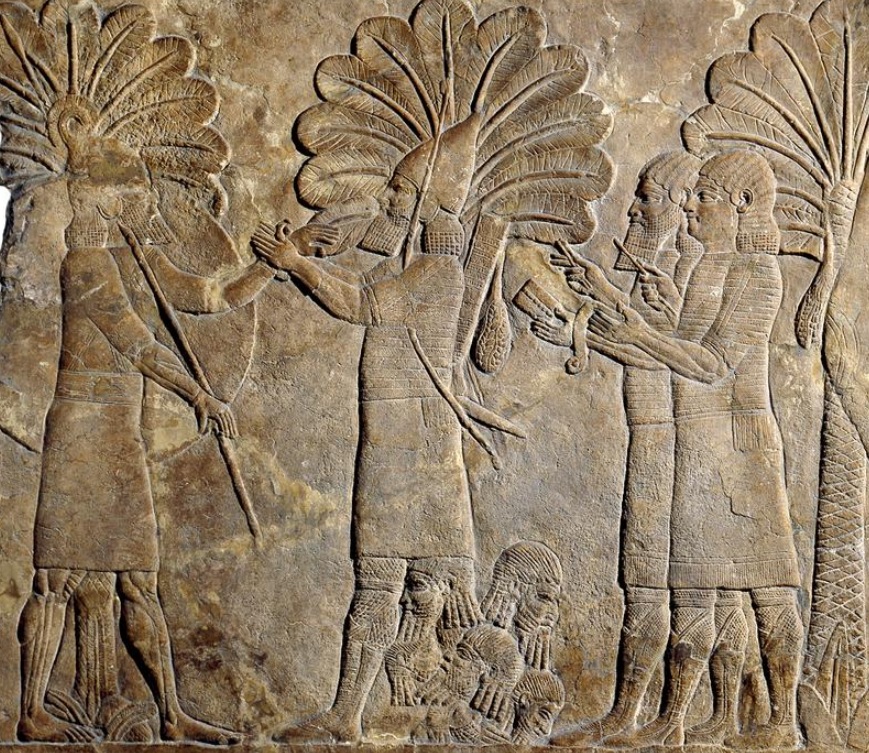
We know that by this period cuneiform was not the only writing system in use in the Neo-Assyrian administrations, as the Aramaic language was also used, and with it the linear alphabetic system in which it was characteristically written. Aramaic was more likely to be written on perishable materials, broadly speaking. Below we can see another Neo-Assyrian depiction from a wall painting where we might suspect that the scribe on the left might be writing Aramaic, while the man in the middle seems to be writing on a clay tablet with a stylus, and so presumably in cuneiform.
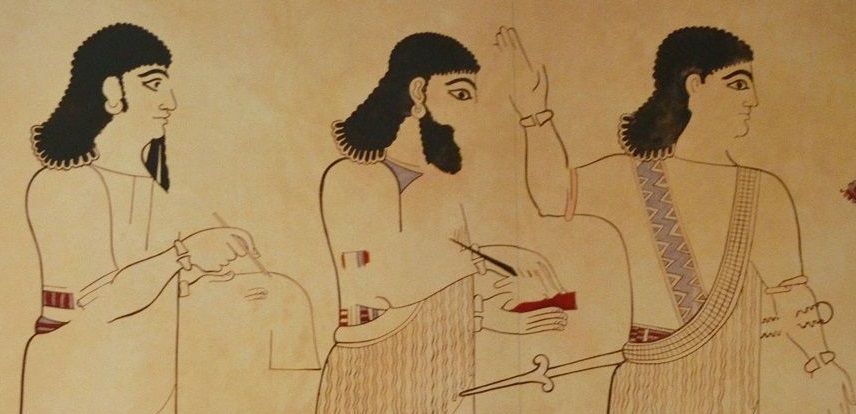
These depictions suggest standing while writing, though apparently in the context of taking notes while something is happening. We might expect that in other contexts such as record-keeping in an administrative setting, other postures would be appropriate, perhaps sitting down in one position or another. If you are interested in reading more about how we can reconstruct cuneiform writing techniques, I would recommend this post by Michele Cammarosano.
From the Near East we head to the Mediterranean, where we again find that depictions of writing can be difficult to find. As I mentioned above, we have no depictions of people writing in Linear B (or for that matter Linear A or Cretan Hieroglyphic) during the second millennium BC. One or two slightly later finds give some impression of writing during the first millennium BC, however. By this time, clay tablets were no longer popular vehicles for inscriptions in the Mediterranean area, and surviving inscriptions tend to be found largely on pieces of pottery as well as other items like tools, jewellery and sculpture. It is also very likely that a significant proportion of writing would have been done on perishable materials that have extremely low chances of surviving in the Mediterranean climate. Such materials could include wooden writing boards covered in wax as well as parchment, papyrus and other similar writing media.
In Archaic and Classical Greece, the depictions of writing that we have tend to show people writing on wooden writing boards, which would have had a hinge in the middle so that the tablet could be folded over and sealed. You might be forgiven for thinking that these sometimes look a bit like laptops!
Folding wooden writing tablets. Left: Detail from a red figure vase painting by the Douris painter (Berlin), image from here, c. 500BC. Right: Greek gravestone showing a reclining woman consulting what looks like a writing board (Getty Villa), image from here, c.100 BC.
Possibly my favourite depiction of writing from Archaic Greece is this Boeotian figurine below, which I came across earlier this year. A man or boy wearing (I assume) some sort of hat is sitting on a stool with a hinged writing board. Some aspects of the figure are crudely shaped, and the stylus he holds is probably a bit bigger than it should be, but then it must be difficult to add very small parts to a clay figure of this type. But the expression of concentration on his face is exquisite. For me this brings together two very important aspects of writing: the materials and methods and physicality involved, which interact with social norms surrounding writing practice, and the cognitive effort needed to accomplish the writing, as language is converted into a sort of visual/physical form to be passed on. (If he looks familiar it may be because I adopted him as the Write With CREWS mascot!)
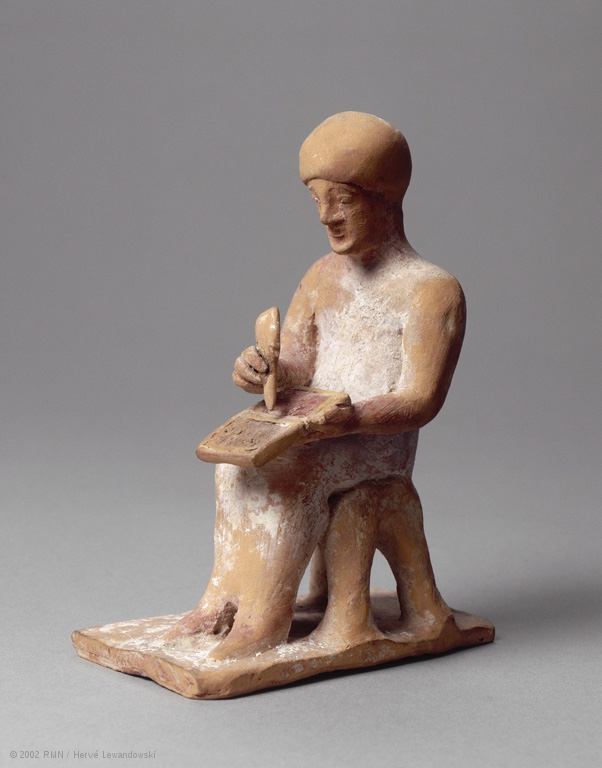
Depictions of writing in the Roman world also commonly feature wooden writing boards, as in the famous fresco of Sappho from Pompeii shown below. “Sappho” (really a Roman woman who has been labelled Sappho erroneously in modern times) holds the stylus to her mouth here, while in the image on the right from Flavia Solva you can see a male Roman writer putting the stylus to the writing board. Notice that the woman on the left holds the writing board in a different orientation from the Greek writers above, more like a book than a laptop! We have sufficient evidence to suggest that a hinged writing board could be oriented in either a ‘portrait’ or a ‘landscape’ manner, to borrow terms from modern computing.
Roman writers with hinged wooden writing boards. Left: The “Sappho” fresco from Pompeiir, image from here. Right: Gravestone of a scribe from Flavia Solva, image from here.
The relief sculpture on the so-called Altar of the Scribes, dedicated by Quintus Fulvius Eunus in the 1st C AD, shows a more complicated image of Roman writing in which documents are collected on a table and multiple individuals are involved – though not all of them are engaged in a writing activity. The central figure seems to be drawing up some documents and folding large sheets of some sort of perishable material, with help from the figures to either side. Although the act of writing is a bit elusive in this image, I wanted to show it because of the quite different interaction between writer and writing medium and surface.

Bringing an end to our survey of the Mediterranean, I was also very interested to find some scribe figures from Cyprus (which some of you may know is one of my beloved areas of specialism!) – they are rare but there are a few interesting examples. Here you can see two figures doing something very similar, sitting with what looks like a papyrus roll pulled taut across the knees. It is difficult not to see some reference to the typical Egyptian scribal pose here, and yet the figures are not sitting cross-legged and the iconography is distinctively Cypriot – this sort of fusion of Mediterranean interests is very typical of the creativity of Cypriot art. I am not quite sure whether the figure on the left has a strange head or is wearing a strange hat or headdress as the museum listing suggests… (On which subject, see below on Mayan scribes and their special headwear!)
Cypriot seated scribes. Left: Image from the Museum of Cycladic art here, 600-500 BC. Right: Image from the New York Met here, 5th-45h C BC.
Another example of a Cypriot scribe lives in the Fitzwilliam Museum here in Cambridge, and I was delighted when I stumbled upon it a couple of years ago. Sadly the scribe has lost their head, but what is very interesting is that they are seated on a stool and bent over a table on which their piece of papyrus or similar is resting as they write. This is somewhat different from the more Egyptian-like poses of the figures above.
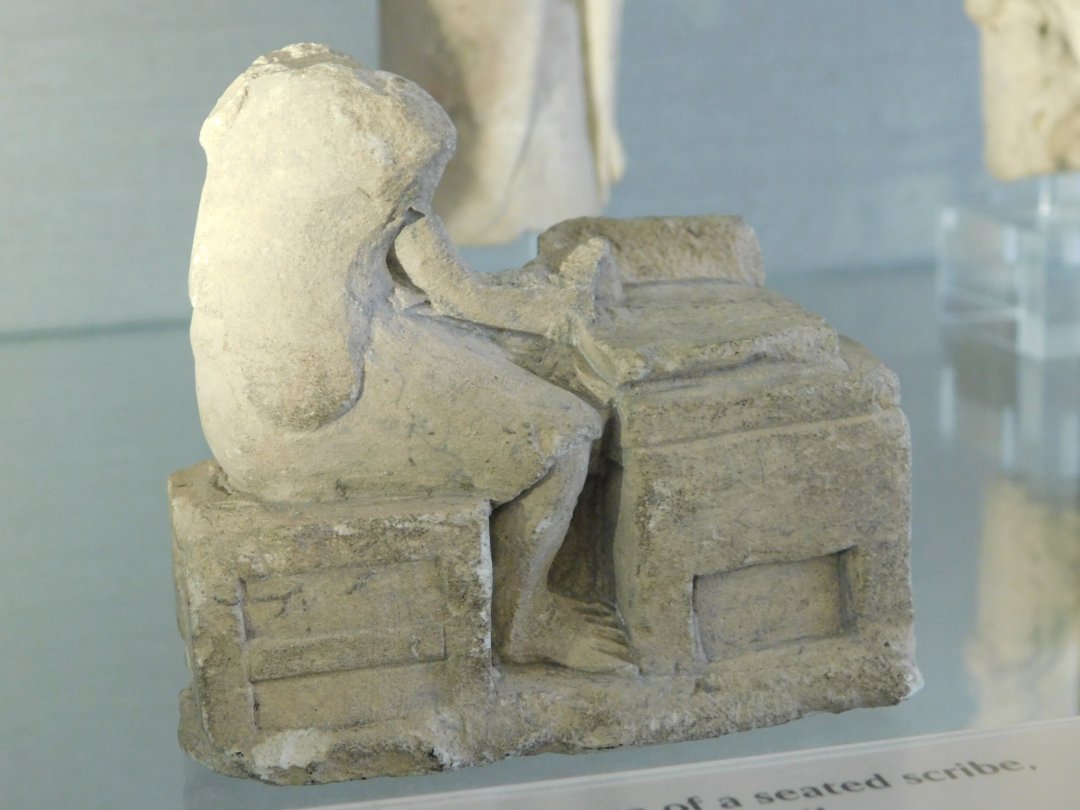
I couldn’t help finishing this post on depictions of writing with a small excursion to the Americas, where Mayan imagery provides us with some very interesting parallels. Mayan scribes are not always human – there are scribe monkeys for example, as well as the famous scribe rabbit (which we adopted as the sort of CREWS pet for our conference last year) – but they do assume human-like poses when writing. Typically the scribe (whether human or animal) sits cross-legged, holding some sort of brush-pen in one hand and sometimes a palette in the other, and bends over writing materials placed on the floor. The iconography and artistic style is very different from what we have seen, but at the same time it is interesting that there are some shared traits with writing in the ancient Mediterranean, Near East and north Africa. This has nothing to do with relations between such far-flung areas – but I think it has everything to do with the physicality of the practice of writing, and the way it necessitates particular postures and interactions with implements and materials.

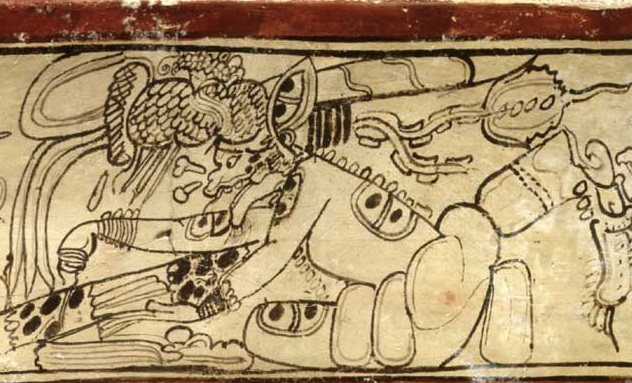
So what do you look like when you are writing? You may not have thought about it much before, but try to imagine what you might look like if someone were to make a small statue or drawing of you! How does your pose change if you are writing with a pen or on a computer? What is your expression like? How do you hold or interact with the implements you are using? These are interesting questions, and ones that were evidently on the agenda in depictions of writing in ancient art.
~ Pippa Steele (PI of the CREWS project)
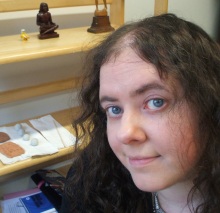















Much can be deduced from scribal errors and how they have been corrected. Assuming that inscribed wall surfaces and rock faces are first marked out from a scheme written conventionally and then chiselled out, error correction then presents a special challenge. Amendment cannot usually replace parts of the surface already removed, and the compromise results sometimes get logged as hapax symbols (e.g., Adiego, “The Carian Language”, 2006, p.41 and note 18). Another instance is a Lycian rockface text (I will hunt out which), where a single stroke, omitted from a letter at the end of one line, was wrongly added to the letter on the line below, showing that the mason was being directed verbally from below and altered the wrong letter. A more recent example is Prokofiev’s fictitious Поручик Киже, who was born from the scribe’s intended Поручики же, “the lieutenants however” via a smudge after к, which the Czar took to be another к.
LikeLike
This is fascinating. I think of how my son looked when he was learning to write. And I love the scribe rabbit.
LikeLike
Very Interesting Thank you Pippa
LikeLike
Reblogged this on Ritaroberts's Blog.
LikeLike